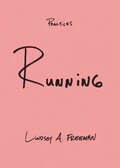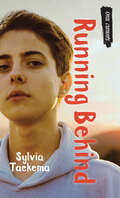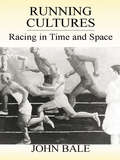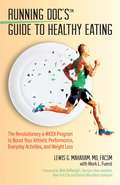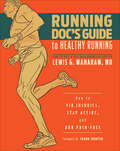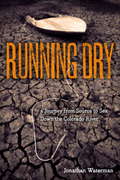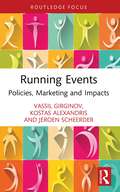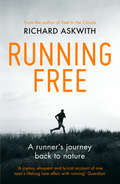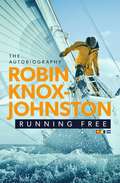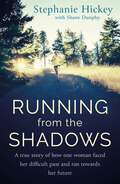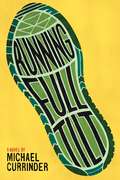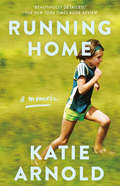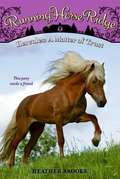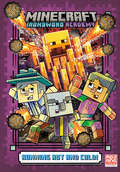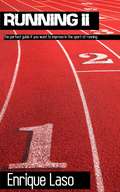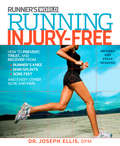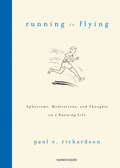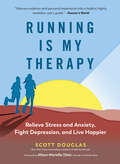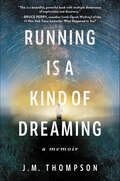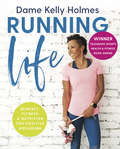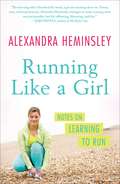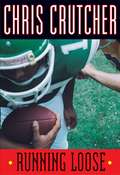- Table View
- List View
Running & Walking For Women Over 40: The Road To Sanity And Vanity
by Kathrine SwitzerA fun, easy, and economical route to fitness and health” “This book will give women everywhere the guidance they need” (Grete Waitz, 9-time winner of the New York City Marathon). Women’s fitness pioneer Kathrine Switzer has been on her feet for 53 years. She knows how running or walking is the fastest, easiest, and least expensive road to fitness for women of any age. For women over forty in particular, it’s vital to fit an exercise regimen into their busy lives, and ensure they can stay active and healthy for many years to come. No matter how inexperienced or old you are, Switzer will guide and ease you into a new exercise schedule, making the time you give yourself the best part of your day—and your future life. Recommendations for shoes, clothing, injury prevention, nutrition, motivation and finding the time in your life will keep you exercising safely and comfortably. For women over forty, Kathrine Switzer’s expert running and walking programs are specifically designed for you, enabling you to keep healthy and enjoy life to the fullest for decades to come. “For many over-forty women, this book will be a passport to the best years of their lives.” —Joan Benoit Samuelson, Olympic Gold Medalist and US marathon record holder
Running (Practices)
by Lindsey A. FreemanIn Running, former NCAA Division I track athlete Lindsey A. Freeman presents the feminist and queer handbook of running that she always wanted but could never find. For Freeman, running is full of joy, desire, and indulgence in the pleasure and weirdness of having a body. It allows for a space of freedom—to move and be moved. Through tender storytelling of a lifetime wearing running shoes, Freeman considers injury and recovery, what it means to run as a visibly queer person, and how the release found in running comes from a desire to touch something that cannot be accessed when still. Running invites us to run through life, legging it out the best we can with heart and style.
Running Back Exchange (NFL Monday Night Football Club series #2)
by Gordon KormanElliot Rifkin does not believe that his friend actually changed places with John Elway during Monday Night Football, but when he tries the mysterious football jersey on for himself, he finds himself looking through the eyes of Barry Sanders. Original.
Running Behind (Orca Currents)
by Sylvia TaekemaEven though he was once his biggest rival, Jake Jarvis is thrilled when Spencer Solomon agrees to join the Diamonds cross-country team to compete in the Barry's Bay provincial championships. Everyone is pumped, everyone is focused, and Jake has to admit, he really likes their chances. At the last moment, Spencer informs the team that he can't go. Jake is furious. But when Spencer explains that he's worried about leaving his wheelchair-bound father alone, Jake gets to work on finding a solution to get Spencer and the Diamonds back on track. This short novel is a high-interest, low-reading level book for middle-grade readers who are building reading skills, want a quick read or say they don’t like to read!
Running Cultures: Racing in Time and Space (Sport in the Global Society)
by John BaleRunning is one of the world's most widely practiced sports and recreations but until now it has intended to elude serious study outside of the natural sciences. John Bale brings the sport into the realm of the humanities by drawing on sources including literature, poetry, film, art and sculpture as well as statistics and training manuals to highlight the tensions, ambiguities and complexities that lie hidden beneath the commonplace notion of running.The text explores both local and personal, as well as communal and global aspects of running and its practitioners. It examines the streets, tracks and stadiums where athletes run, the races in which they compete, and the running relationships such as exist between the athlete and the coach, between runners and between the athlete and spectator. It discusses the importance of speed and records, how running has been used to symbolise resistance and transgression, and the extent to which it can be associated with a healthy lifestyle.Running Cultures provides new ways of seeing a familiar sporting phenomenon. it will appeal to both students and researchers with an interest in running in particular, and sport and leisure cultures more generally.
Running Doc's Guide to Healthy Eating: The Revolutionary 4-Week Program to Boost Your Athletic Performance, Everyday Activities, and Weight Loss
by Dr Lewis G. MaharamAn easily implemented sports nutrition program for the weekend warrior, the Olympic athlete, and everyone in between from one of the country’s most respected experts in sports medicine. In Running Doc’s Guide to Healthy Eating, readers will discover Dr. Lewis G. Maharam’s unique Fueling Plates Program. Developed in 2012, it has helped countless sofa spuds who really just want to get off the couch and lose weight, marathoners competing for a place at the Olympic trials, and everyone in between, including recreational athletes who play tennis, soccer, basketball and other running sports. The Fueling Plates Program is designed primarily to boost the performance of athletes, but can also boost the health of the average person, athletic or not. Every day at Maharam’s busy New York City practice, in addition to treating sports injuries, he offers his patients nutritional advice. They ask him: &“When should I eat before the marathon?” “Do I really need to drink eight glasses of water a day?” “What about sports drinks?” “Should I use energy gels?” “Gingko?” “Glucosamine?” “Raspberry ketones?” The questions come because the bulk of the sports-nutrition books on the market today make fueling your body sound like a scientific experiment. The Running Doc’s Guide to Healthy Eating explains why it’s time to ditch the difficult-to-use food pyramid put out by the USDA in favor of a hands-on experience of your actual plate – what Maharam calls Fueling Plates. It shows, step by step, how readers can apply the program to feel and perform better and have more energy. Those who are already exercising will get faster by eating to fuel their body more efficiently. Even everyday activities become easier with the Fueling Plates Program. Readers who are willing to take advantage of everything revealed in the book, from what to eat to reduce muscle soreness after exercising to how much to drink to be hydrated properly to an individualized nutrition program, will transform their lives.
Running Doc's Guide to Healthy Running: How to Fix Injuries, Stay Active, and Run Pain-Free
by Lewis G. MaharamFor a runner, injury is a terrible fate. Yet every year, nearly half of America's runners suffer an injury severe enough to bring them to a halt. Trust the Running Doc to get you back on your feet. Dr. Lewis G. Maharam, MD, is the most trusted authority on running health and running injuries, and his guide will help you avoid or fix nearly every common running-related injury. If you're already injured, Running Doc's book will help you diagnose, treat, and recover to run pain-free. From head to toenails, Running Doc's Guide to Healthy Running is the most comprehensive guide to running injuries and preventative care. Running Doc offers simple, effective treatments for every common running injury and also delivers easy-to-follow advice on the best way to prepare for and enjoy running events of all types and distances. Running Doc's Guide to Healthy Running addresses: How running is good for your health Healthy training programs for races and running events Choosing running shoes for your gait and feet Guidelines for running in cold weather, hot weather, and dry climates Safe and healthy marathon and half-marathon training Running with a cold, the flu, and aches and pains Feet and ankle injuries including plantar fasciitis, Lisfranc, sprains Legs and knee injuries including Runner's Knee, IT Band Syndrome, tendinitis Back pain from sciatica, piriformis syndrome, and related issues No matter your malady, Running Doc has got you covered. Get healthy and get back on your feet with Running Doc's Guide to Healthy Running.
Running Dry
by Jonathan WatermanIn 1869, John Wesley Powell led a small party down the Green and Colorado Rivers in a bold attempt to explore the Grand Canyon for the first time. After their monumental expedition, they told of raging rapids, constant danger, and breathtaking natural beauty of the American landscape at its most pristine.Jon Waterman combines sheer adventure and environmental calamity in this trailblazing cautionary account of his 2008 trip down the overtaxed, drying Colorado. Dammed and tunneled, forced into countless canals, trapped in reservoirs and harnessed for electricity, what once was untamed and free is now humbled, parched, and so yoked to human purposes that in most years it trickles away 100 miles from its oceanic destination.Waterman writes with informal immediacy in this eye-witness account of the many demands on the Colorado, from irrigating 3.5 million acres of farmland to watering the lawns of Los Angeles. He shows how our profligacy and inexorable climate change spark political conflict, and how we can avert this onrushing ecological crisis. As he follows Powell afloat and afoot, Waterman reaches out both to adventure travelers and to scientists, conservationists, environmentalists, and anyone interested in the fragile interplay between nature and humans.
Running Events: Policies, Marketing and Impacts (European Association for Sport Management Series)
by Jeroen Scheerder Vassil Girginov Kostas AlexandrisThis is the first book to critically examine the relationship between running events in local, national, and international welfare policy, their marketing and management, and the resulting social impacts. Drawing on original empirical research, the book presents a series of illustrative case studies, with each chapter containing take-home messages for sport and events managers looking to improve their professional practice. Developing a new theoretical perspective on running events, the book presents data from around the world, including five European countries, the US and China. It covers different types of events, from big city marathons to community park runs, and new types of events such as path and trail runs, night runs, ultra runs, xtreme runs and obstacle run, presenting a typology of running events that will help shape future analysis of this rapidly growing sector. The book also examines the market for running events, runners&’ socio-demographic profiles, the main management and marketing approaches and techniques used by organisers, and the socio-economic impacts of running events, such as the effect on people&’s attitudes and behaviours, organisational planning, city promotion and social interactions. Running events are central to sport at all levels, from grassroots to professional, so this book is essential reading for any student, researcher or practitioner working in sport management, sport development, sport policy, the sociology of sport, or event studies.
Running Free: A Runner’s Journey Back to Nature
by Richard AskwithShortlisted for the 2015 Thwaites Wainwright prize for nature writing Richard Askwith wanted more. Not convinced running had to be all about pounding pavements, buying fancy kit and racking up extreme challenges, he looked for ways to liberate himself. His solution: running through muddy fields and up rocky fells, running with his dog at dawn, running because he's being (voluntarily) chased by a pack of bloodhounds, running to get hopelessly, enjoyably lost, running fast for the sheer thrill of it. Running as nature intended. Part diary of a year running through the Northamptonshire countryside, part exploration of why we love to run without limits, Running Free is an eloquent and inspiring account of running in a forgotten, rural way, observing wildlife and celebrating the joys of nature.An opponent of the commercialisation of running, Askwith offers a welcome alternative, with practical tips (learned the hard way) on how to both start and keep running naturally – from thawing frozen toes to avoiding a stampede when crossing a field of cows. Running Free is about getting back to the basics of why we love to run.
Running Free: The Autobiography
by Robin Knox-JohnstonSir Robin Knox-Johnston burst to fame when he became the first man ever to complete a single-handed, non-stop circumnavigation of the world. Now, 50 years on from that famous voyage, he reveals the true, extraordinary story of his life. After leaving school, he immediately joined the Royal Naval Reserve before serving in the merchant navy and travelling the world. During that time, he spied for the British government in the Gulf, worked in the South African dockyards, and built his boat Suhaili in Bombay, before sailing home to England. In June 1968, he set sail in Suhaili in the Sunday Times Golden Globe Race, and Running Free vividly brings to life that remarkable voyage, where he was the only person to finish the race, completing his journey on 22 April 1969 and thus entering the record books. Once back home, he set up a hugely successful business and continued his naval adventures, completing a second solo circumnavigation of the globe in 2007 - at 68, he became the oldest to complete this feat. Knox-Johnston's insatiable appetite for life and adventure shines through these pages, making this book a must for all sailing enthusiasts, readers of books by Ranulph Fiennes and Chris Bonington, or for anyone who has felt that the time for putting up your feet can always be put back to another day.
Running From the Shadows: A true story of how one woman faced her past and ran towards her future
by Stephanie HickeyIn Running from the Shadows Stephanie Hickey tells, in her own words, how she survived abuse at the hands of a trusted family member and of how running, a simple physical activity helped her achieve mindfulness, but also to rediscover love and faith in her body - to reclaim it. Charting her life growing up in the rolling countryside of Waterford in the safety of her beloved family to the moment her childhood was shattered, to the court case where she waived her anonymity, to how she was able to reclaim a sense of herself through the sport which became like a therapy, Running from the Shadows is told with humour, strength and incredible courage -- a book that reveals how, even when things seem at their bleakest, a run through the Irish countryside, can bring you back into the light.
Running From the Shadows: A true story of how one woman faced her past and ran towards her future
by Stephanie HickeyIn Running from the Shadows Stephanie Hickey tells, in her own words, how she survived abuse at the hands of a trusted family member and of how running, a simple physical activity helped her achieve mindfulness, but also to rediscover love and faith in her body - to reclaim it. Charting her life growing up in the rolling countryside of Waterford in the safety of her beloved family to the moment her childhood was shattered, to the court case where she waived her anonymity, to how she was able to reclaim a sense of herself through the sport which became like a therapy, Running from the Shadows is told with humour, strength and incredible courage -- a book that reveals how, even when things seem at their bleakest, a run through the Irish countryside, can bring you back into the light.
Running Full Tilt
by Michael CurrinderPraised by Jack Gantos, author of Dead End in Norvelt, as "a quick read with a kick at the finish," this debut novel sensitively and memorably captures a teen runner's relationship with his autistic older brother.Like most siblings, Leo and Caleb have a complicated relationship. But Caleb's violent outbursts literally send Leo running. When the family is forced to relocate due to Caleb's uncontrollable behavior, Leo tries to settle into a new school, joining the cross-country team and discovering his talent for racing and endurance for distance. Things even begin to look up for Leo when he befriends Curtis, a potential state champion who teaches Leo strategy and introduces him to would-be girlfriend, Mary. But Leo's stability is short-lived as Caleb escalates his attacks on his brother, resentful of his sport successes and new friendships.Leo can't keep running away from his problems. But, with a little help from Curtis and Mary, he can appreciate his worth as a brother and his own capacity for growth, both on and off the field.Praise from Jack Gantos, author of Dead End in Norvelt, Hole in My Life and The Trouble With Me: "Currinder's novel, Running Full Tilt, is a fast-paced convincing drama of a young runner whose legs circle him back to the many conflicts he is trying to escape--but he can't outrun himself. A quick read with a kick at the finish."Praise from Paul Volponi, author of The Final Four, Black and White, and Rikers High:"We feel the inner strength it takes to compete on every page of this splendid narrative, until, as readers, we are running as well--engrossed, and loving every step of the journey."
Running Home: A Memoir
by Katie ArnoldIn the tradition of Wild and H Is for Hawk, an Outside magazine writer tells her story—of fathers and daughters, grief and renewal, adventure and obsession, and the power of running to change your life.I’m running to forget, and to remember. For more than a decade, Katie Arnold chased adventure around the world, reporting on extreme athletes who performed outlandish feats—walking high lines a thousand feet off the ground without a harness, or running one hundred miles through the night. She wrote her stories by living them, until eventually life on the thin edge of risk began to seem normal. After she married, Katie and her husband vowed to raise their daughters to be adventurous, too, in the mountains and canyons of New Mexico. But when her father died of cancer, she was forced to confront her own mortality. His death was cataclysmic, unleashing a perfect storm of grief and anxiety. She and her father, an enigmatic photographer for National Geographic, had always been kindred spirits. He introduced her to the outdoors and took her camping and on bicycle trips and down rivers, and taught her to find solace and courage in the natural world. And it was he who encouraged her to run her first race when she was seven years old. Now nearly paralyzed by fear and terrified she was dying, too, she turned to the thing that had always made her feel most alive: running. Over the course of three tumultuous years, she ran alone through the wilderness, logging longer and longer distances, first a 50-kilometer ultramarathon, then 50 miles, then 100 kilometers. She ran to heal her grief, to outpace her worry that she wouldn’t live to raise her own daughters. She ran to find strength in her weakness. She ran to remember and to forget. She ran to live. Ultrarunning tests the limits of human endurance over seemingly inhuman distances, and as she clocked miles across mesas and mountains, Katie learned to tolerate pain and discomfort, and face her fears of uncertainty, vulnerability, and even death itself. As she ran, she found herself peeling back the layers of her relationship with her father, discovering that much of what she thought she knew about him, and her own past, was wrong. Running Home is a memoir about the stories we tell ourselves to make sense of our world—the stories that hold us back, and the ones that set us free. Mesmerizing, transcendent, and deeply exhilarating, it is a book for anyone who has been knocked over by life, or feels the pull of something bigger and wilder within themselves. “A beautiful work of searching remembrance and searing honesty . . . Katie Arnold is as gifted on the page as she is on the trail. Running Home will soon join such classics as Born to Run and Ultramarathon Man as quintessential reading of the genre.”—Hampton Sides, author of On Desperate Ground and Ghost Soldiers
Running Horse Ridge #2: A Matter of Trust
by Heather BrooksHorse friends forever?Emily Summers is on a mission. A scared little pony has come to Running Horse Ridge, the horse rescue ranch where she lives. Hercules desperately needs a friend, and Emily knows exactly how the lonely pony feels. She is new to Running Horse Ridge herself. But unlike Hercules, she has begun to make new friends, and she has the love of her horse friend forever, Sapphire. Can Emily get Hercules to trust her before he is beyond help?
Running Hot and Cold! (Minecraft Ironsword Academy)
by Caleb Zane HuettAn all-new Minecraft chapter book series continues with Book Three of The Ironsword Academy!When the Evoker King transformed himself into the Evoker Kid, a total noob who only wants to experience everything the world of Minecraft has to offer, he didn&’t leave a clue as to what he wanted Harper and her friends to do. Now that the team is closer than ever to facing the Ender Dragon, Harper takes it upon herself to figure out their whole plan down to the last detail—but she doesn&’t know how they&’re going to make it work with the odds stacked against them. Everything starts to feel overwhelming, especially since they don&’t really know what will happen to Eek after they beat the Ender Dragon.Find out in the only official chapter book series—based on the most popular video game of all time—that takes a group of intrepid Minecraft player on amazing journeys where they solve problems and unravel mysteries in the real world and in video game world.Don&’t miss these other great Minecraft Series:• Minecraft Woodsword Chronicles books 1-6• Minecraft Stonesword Saga books 1-6© 2025 Mojang AB. All Rights Reserved. Minecraft, the Minecraft logo, the Mojang Studios logo and the Creeper logo are trademarks of the Microsoft group of companies.
Running II
by Enrique Laso Bethany AndrewsAfter the sensation success of RUNNING, Nº1 in many countries in the genre of running as well as in Sports in general, Enrique Laso received dozens of messages requesting a new guide, with the same enjoyable and direct style, but for those who want to advance a little further. RUNNING II is a short guide directed to those runners who are already considering improving their times, competing in popular races, or even jumping to the track where they can run with the best. The following advice, experience, reflections, and easy-to-follow training plans will help you progress as a runner. RUNNING II is the perfect guide if you want to improve in the sport of running. And running is living more happily. THE SEQUEL TO THE BESTSELLER IN RUNNING AND SPORTS
Running Injury-Free: How to Prevent, Treat, and Recover From Runner's Knee, Shin Splints, Sore Feet a nd Every Other Ache and Pain
by Joseph EllisRunning Injury-Free by Dr. Joseph Ellis, DPM uses anecdotal examples from Ellis' own patients and experiences in order to discuss injury-prevention, treatment, and recovery. He implements a clinical approach toward treating the most common running-related injuries, as well as providing detailed background situations to describe how each injury can happen, so the reader can recognize poor habits or compare training and running practices in his or her own experience. In this updated version, content relating to shoes and shoe selection, "over the counter" treatments, orthotic techniques and materials, Piriformis Syndrome, chiropractic medicine and acupuncture, stretching techniques, nutrition and supplements, injuries related to minimalist runners, as well as running issues for women, children, and endurance runners will be updated to reflect timely practices and research.
Running Is Flying: Aphorisms, Meditations, and Thoughts on a Running Life
by Paul E. RichardsonRunning is hard work, yes. But it should also be fun and exhilarating. At its best, it recaptures the joy we experienced before running was recast as punishment or penance, when we would sprint out of the shadows in a darkened cul-de-sac to kick a can, chase someone on the playground, or race our dog along the beach.While that joy can be easy to find (remember finishing your first 5k?), it can be monumentally difficult to sustain. Humor helps.The intent of Running is Flying--a collection of over 60 aphorisms, thoughts and meditations on the running life by Paul E. Richardson--is to provide encouragement, levity, and perspective to a sport that has a tendency to take itself a bit too seriously.Wonderfully illustrated by British artist Paul Cox, Running Is Flying makes a great gift for the runner in your life, even if that runner happens to be yourself.
Running Is My Therapy: Relieve Stress And Anxiety, Fight Depression, And Live Happier
by Scott DouglasA lifelong runner’s groundbreaking guide to fighting depression and anxiety, one run at a time Everyone knows that running builds stronger muscles and a healthier heart. In Running Is My Therapy, longtime runner Scott Douglas shows how endurance running is also the best form of exercise to develop a healthier brain. A natural antidepressant, running reinforces the benefits of therapy and triggers lasting, positive physiological changes. In fact, some doctors now “prescribe” a running regimen as part of their first-line treatment plan for depression. Marshaling expert advice and a growing body of research, Douglas explains how we can all use running to improve mental health—and live happier.
Running Is a Kind of Dreaming: A Memoir
by J. M. ThompsonA powerful, breathtaking memoir about a young man's descent into madness, and how running saved his life.“Voluntary or involuntary?” asked the nurse who admitted J. M. Thompson to a San Francisco psychiatric hospital in January 2005. Following years of depression, ineffective medication, and therapy that went nowhere, Thompson feared he was falling into an inescapable darkness. He decided that death was his only exit route from the torture of his mind. After a suicide attempt, he spent weeks confined on the psych ward, feeling scared, alone, and trapped. One afternoon during an exercise break he experienced a sudden urge. “Run, I thought. Run before it’s too late and you’re stuck down there. Right now. Run. ” The impulse that starts with sprints across a hospital rooftop turns into all night runs in the mountains. Through motion and immersion in the beauty of nature, Thompson finds a way out of the hell of depression and drug addiction. Step by step, mile by mile, his body and mind heal. In this lyrical, vulnerable, and breathtaking memoir, J. M. Thompson, now a successful psychologist, retraces the path that led him from despair to wellness, detailing the chilling childhood trauma that caused his depression, and the unorthodox treatment that saved him. Running Is a Kind of Dreaming is a luminous literary testament to the universal human capacity to recover from our deepest wounds.
Running Life: Mindset, fitness & nutrition for positive wellbeing
by Kelly HolmesRunning Life is an inspirational and attainable guide to how mindset, excercise and diet - the 'Big Three' as Dame Kelly terms them - interlink to transform your overall wellbeing. Divided into three sections, Mindset, Fitness and Nutrition, this book will teach you how to make positive changes to your life and empower yourself, with each chapter featuring numerous tips from Dame Kelly. Change your mindset to reach emotional wellbeing with easy-to-follow mindfulness exercises, keep your body strong with running, strength and flexibility exercises, and learn which foods best nourish your body with 5 ways to improve the way you eat. Drawing on her own experience, Dame Kelly guides you through how to harness your mind and reap the benefits of good food and exercise.
Running Like a Girl
by Alexandra HeminsleyA charming, hilarious, and practical book about one woman's stumbling, painful efforts to start running and how becoming a runner ultimately transformed her relationships, her body, and her life. In her twenties, Alexandra Heminsley spent more time drinking white wine than she did in pursuit of athletic excellence. When she decided to take up running in her thirties, she had high hopes for a blissful runner's high and immediate physical transformation. After eating three slices of toast with honey and spending ninety minutes on iTunes creating the perfect playlist, she hit the streets--and failed miserably. The stories of her first runs turn the common notion that we are all "born to run" on its head--and exposes the truth about starting to run: it can be brutal. Running Like a Girl tells the story of getting beyond the brutal part, how Alexandra makes running a part of her life, and reaps the rewards: not just the obvious things, like weight loss, health, and glowing skin, but self-confidence and immeasurable daily pleasure, along with a new closeness to her father--a marathon runner--and her brother, with whom she ultimately runs her first marathon. But before her first marathon, she has to figure out the logistics of running: the intimidating questions from a young and arrogant sales assistant when she goes to buy her first running shoes, where to get decent bras for the larger bust, how not to freeze or get sunstroke, and what (and when) to eat before a run. She's figured out what's important (pockets) and what isn't (appearance), and more. For any woman who has ever run, wanted to run, tried to run, or failed to run (even if just around the block), Heminsley's funny, warm, and motivational personal journey from non-athlete extraordinaire to someone who has completed five marathons is inspiring, entertaining, practical, and fun.
Running Loose
by Chris CrutcherLouie Banks has it made. He's got a starting spot on the football team, good friends, and a smart, beautiful girlfriend who loves him as much as he loves her. Early in the fall, he sees all his ideas of fair play go up in smoke; by spring, what he cares about most has been destroyed. How can Louie keep going when he's lost everything?

